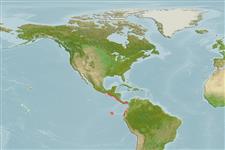Élasmobranches (requins et raies) (sharks and rays) >
Carcharhiniformes (Ground sharks) >
Triakidae (Houndsharks) > Triakinae
Etymology: Mustelus: Latin for weasel, an ancient name for sharks, possibly referring to the pointed snouts, swift movements and/or rapacious feeding behavior of smaller predatory sharks [strictly not tautonymous with Squalus mustelus Linnaeus 1758 since type was designated by the ICZN]. (See ETYFish); dorsalis: Latin for “of the back,” referring to “projection of the posterior angle of the first dorsal fin to the vertical of the origin of the ventrals”. (See ETYFish).
More on author: Gill.
Environment: milieu / climate zone / depth range / distribution range
Écologie
marin démersal; profondeur 20 - 200 m (Ref. 96339). Tropical; 20°N - 5°S
Eastern Pacific: southern Mexico to Peru.
Length at first maturity / Taille / Poids / Âge
Maturity: Lm ?, range 43 - ? cm
Max length : 64.0 cm mâle / non sexé; (Ref. 9253)
An inshore bottom-dwelling shark found on the continental shelves. Feeds primarily on shrimps and probably other crustaceans. Viviparous (with a yolk-sac placenta), with 4 young in a litter. Size at birth, 21 to 23 cm.
Viviparous, with a yolk-sac placenta (Ref. 244).
Compagno, L.J.V., 1984. FAO Species Catalogue. Vol. 4. Sharks of the world. An annotated and illustrated catalogue of shark species known to date. Part 2 - Carcharhiniformes. FAO Fish. Synop. 125(4/2):251-655. Rome: FAO. (Ref. 244)
Statut dans la liste rouge de l'IUCN (Ref. 130435)
Menace pour l'homme
Harmless
Utilisations par l'homme
Pêcheries: intérêt commercial mineur
Plus d'informations
Taille/ÂgeCroissanceLongueur-poidsLongueur-longueurFréquences de longueursMorphométrieMorphologieLarvesDynamique des populations larvairesRecrutementAbondanceBRUVS
RéférencesAquacultureProfil d'aquacultureSouchesGénétiqueElectrophoresesHéritabilitéPathologiesTraitementNutrientsMass conversion
CollaborateursImagesStamps, Coins Misc.SonsCiguateraVitesseType de nageSurface branchialeOtolithesCerveauxVision
Outils
Articles particuliers
Télécharger en XML
Sources Internet
Estimates based on models
Preferred temperature (Ref.
123201): 14.8 - 26, mean 16.6 °C (based on 31 cells).
Phylogenetic diversity index (Ref.
82804): PD
50 = 0.5000 [Uniqueness, from 0.5 = low to 2.0 = high].
Bayesian length-weight: a=0.00224 (0.00105 - 0.00478), b=3.14 (2.97 - 3.31), in cm total length, based on LWR estimates for this Genus-body shape (Ref.
93245).
Niveau trophique (Ref.
69278): 3.6 ±0.55 se; based on food items.
Résilience (Ref.
120179): Très faible, temps minimum de doublement de population supérieur à 14 ans (Fec=4).
Fishing Vulnerability (Ref.
59153): Very high vulnerability (79 of 100).
Nutrients (Ref.
124155): Calcium = 36.2 [10.6, 179.4] mg/100g; Iron = 0.511 [0.153, 1.851] mg/100g; Protein = 20.7 [18.4, 23.0] %; Omega3 = 0.0958 [, ] g/100g; Selenium = 72.1 [21.3, 262.4] μg/100g; VitaminA = 18.2 [6.7, 48.0] μg/100g; Zinc = 1.12 [0.50, 2.28] mg/100g (wet weight);
